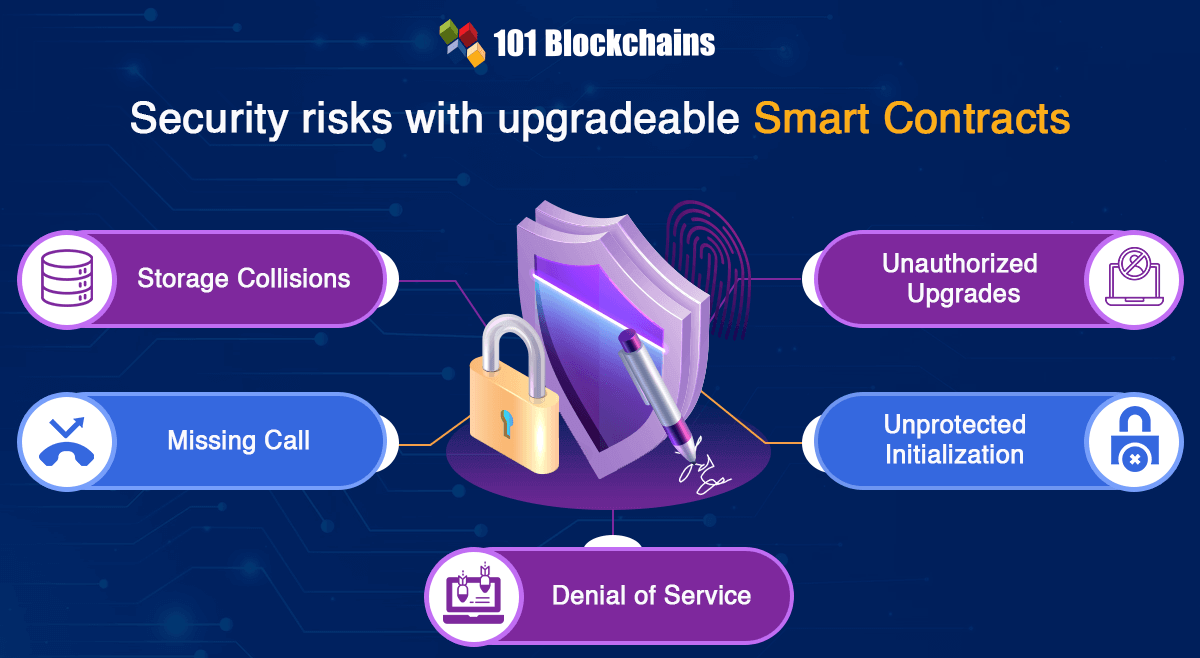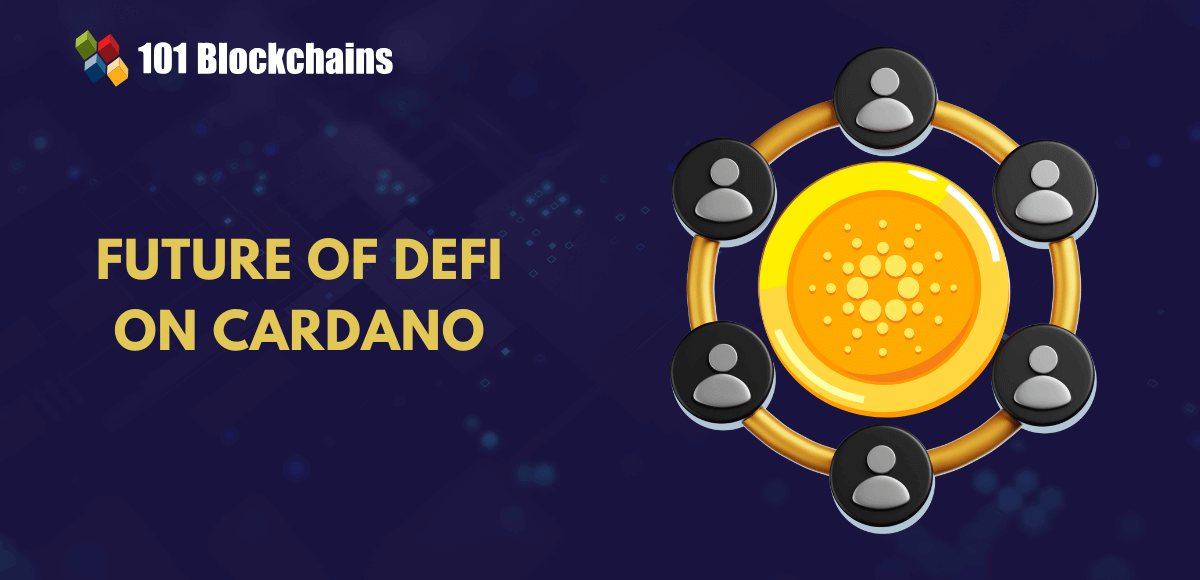Learn how blockchain truly works, master key definitions, and uncover what makes smart contracts so "smart." Dive into the fundamentals, gain valuable insights, and start your blockchain journey today!

- Solidity & Smart Contracts
James Howell
- on January 11, 2024
An Introduction to Upgradeable Smart Contracts
Smart contracts are the core element of the blockchain landscape and serve a crucial role in all dApps and web3 solutions. The answers to “What is upgradeable smart contracts?” create doubts regarding the immutability of smart contracts. After all, immutability is one of the key value propositions of smart contracts. However, it is also important to understand that the immutability of smart contracts creates some prominent limitations.
Immutability is an essential requirement for achieving decentralization and security of smart contracts. Upgradeable smart contracts could help developers leverage proxy patterns for modifying the functionality of contracts after deployment. Interestingly, upgradeable smart contracts also help safeguard the decentralization and security of smart contracts. Let us learn more about upgradeable smart contracts, their working mechanisms, use cases, and limitations.
Understand the complete smart contract development lifecycle with the Smart Contracts Development Course
Understanding an Upgrade in Smart Contracts
The foremost highlight in an upgradeable smart contracts guide points to the reason for introducing an upgrade. Smart contracts have been developed as binding agreements between the involved participants. However, it is also important to think of scenarios when the parties associated with a smart contract want to change the terms of the agreement. On the other hand, you can also need an upgrade to smart contracts to fix bugs in the code. Furthermore, upgrades could also help in adding new features or changing the rules of governance to adapt to new market models and trends.
Is it really necessary? Yes, it is reasonable to think of such questions when you learn upgradeable smart contracts fundamentals. Without upgradeable smart contracts, you cannot deploy a new variant of the contract and update all the other contracts that have interacted with the old contract.
You would also have to migrate all states from the old contract to the new contract manually. In addition, developers would have to inform all users about using the new contract alongside managing the old contract. All these tasks can consume a lot of time and cost, thereby validating the need for upgradeable smart contracts.
Learn about the critical vulnerabilities and security risks in smart contract development with the Smart Contracts Security Course
Definition of Upgradeable Smart Contracts
Smart contracts are popular assets in the modern technology landscape that have redefined conventional transactions and the exchange of information. The immutability of smart contracts is a prominent highlight that develops trust among the users of smart contracts. The upgradeable smart contracts example shows a different approach to solving the issues arising from immutability. Upgradeable smart contracts can help in addressing security risks and adding new features without migrating all activities to a new smart contract.
One of the first approaches followed for smart contract updates without state migrations is the data separation pattern. In this approach, you have to break a smart contract into logic and storage contracts with separate functionalities. However, the data separation pattern creates problems as constant calls between the logic and storage contracts would require gas.
The answers to “What is upgradeable smart contracts?” point to how USCs depend on proxies. A fixed proxy contract can store the state of the system and a modifiable logic address. As compared to conventional contracts, users could interact with the proxy in upgradeable smart contracts.
The proxy also forwards the calls to the business logic contract, and logic contracts don’t have to store user data. Therefore, the upgrade process becomes easier with the deployment of a new logic contract. You would need only the proxy contract to replace the old address.
Working Mechanism of Upgradeable Smart Contracts
The working mechanism of upgradeable smart contracts is an important highlight in every upgradeable smart contracts guide and the crucial components. You can find three distinct components in the architecture of upgradeable smart contracts. The components include a Proxy contract, an Implementation contract, and a ProxyAdmin contract.
-
Proxy Contract
The Proxy contract is the smart contract with which the user can interact directly. It holds the contract state and takes care of forwarding transactions to the implementation contract.
-
Implementation Contract
The next important aspect in guides to learn upgradeable smart contracts points to implementation contracts. It offers the skeleton logic alongside the data and also helps in instantiating variables. The proxy contract can interact with the implementation contract through delegate calls.
-
ProxyAdmin Contract
The ProxyAdmin contract is another crucial contract in the working pattern of upgradeable smart contracts. It helps in linking the Proxy and Implementation contracts. On top of it, the contract also holds authority over the Proxy contract for upgrading the Proxy contract.
Learn about the fundamentals of smart contracts & solidity with our free Solidity & Smart Contracts E-book
Why Should You Use Upgradeable Smart Contracts?
The fundamentals of upgradeable smart contracts provide a clear response to the question. As the trends in web3 evolve and change at a radical pace, it is important to look for solutions to modify smart contracts after deployment. However, you would always think before using an upgradeable smart contracts OpenZeppelin package or challenging the immutability of smart contracts. Interestingly, upgradeable smart contracts could offer more promising advantages with the flexibility to change smart contracts after deployment.
Developers could use upgradeable smart contracts to fix undetected vulnerabilities in smart contracts without creating new contracts. Upgradeable smart contracts could help in introducing new features alongside adapting to new trends without developing a new contract. Developers could also save money on gas fees without the need to develop and deploy a new smart contract from scratch.
The review of an upgradeable smart contracts example could also show that they can offer data consistency, thereby ensuring security. For example, user balances on smart contracts do not change during upgrades, thereby reducing migration problems. Developers don’t have to change the contract address, thereby ensuring easier transition and limited fragmentation.
Build your identity as a certified blockchain expert with 101 Blockchains’ Blockchain Certifications designed to provide enhanced career prospects.
Important Aspects in the Dynamics of Upgradeable Smart Contracts
The next important highlight in a guide on upgradeable smart contracts points to the notable components. Here are the prominent highlights that drive the mechanics of upgradeable smart contracts.
-
Transparent Proxy
Transparent proxies help in managing upgradability and access control in the proxy contract. The admins and users are restricted to logic within their access range. Every upgradeable smart contracts guide focuses on the importance of transparent proxy patterns.
It uses the ‘delegatecall’ function for delegating the execution of function calls for an implementation contract. The mechanism involves the two contracts, such as proxy and implementation contracts. If you send transactions to Proxy contract, it would forward them to the Implementation contract and preserve the context.
-
Universal Upgrade Proxy Standard
The Universal Upgrade Proxy Standard or UUPS would be a cost-efficient approach for ensuring upgradeability of smart contracts. It is an important highlight in answers to “What is upgradeable smart contracts?” as it does not require definition of storage in proxy contracts. The UUPS approach utilizes the same storage layout as the implementation contract.
On the other hand, it ensures a cheaper upgrade and requires more attention to avoid rearrangement of storage layouts in upgraded contracts. Smart contract developers choose UUPS as they offer same versatility as transparent proxies. On top of that, they are cost-effective for deployment as the upgrade logic is not included in the proxy contract.
What are Diamonds in Upgradeable Smart Contracts?
The review of every new upgradeable smart contracts example creates curiosity about their working mechanisms. Diamonds are one of the notable highlights in the working mechanism of upgradeable smart contracts. They help in introducing a cascade mechanism for directing function requests to corresponding implementation contracts through mapping systems.
The system can break down logic, as specified in the upgrade interface, and convert it into specialized implementation contracts or facets. Each facet has a unique address documented in the mapping. Diamonds can help in addressing different setbacks associated with UUPS upgrade approach.
Diamond Cut feature ensures that after upgrade, you can execute external function calls while isolating initialization logic from implementation and proxy contracts. The single transaction execution feature works by the combination of upgrade execution and initialization alongside initializing and securing new state variables.
You would also find isolated initialization logic in diamonds mechanism as it would separate the initialization logic from proxy and implementation contracts. It can help in ensuring safeguards against potential external threats. The discussions to learn upgradeable smart contracts also focus on the DiamondMultiInit feature in Diamond approach. The unique feature helps streamline the upgrade process and enables multiple initialization of all variables.
The diamond structure provides a secure, comprehensive, and flexible upgrade mechanism that improves overall efficiency. However, it is new, and many developers would think twice before using the approach to upgrade smart contracts.
Excited to learn about the best practices to resolve web3 security threats? Enroll now in the Certified Web3 Hacker (CW3H)™ Certification
Implementation of Upgradeable Smart Contracts
The critical aspects of an upgradeable smart contracts guide would also focus on how you cannot find a single standard for the implementation of upgradeable smart contracts. Developers can leverage multiple third-party libraries and EIPs. For example, EIP-1538 is suitable for transparent contract standards, EIP-1967 is useful for proxy storage slots, and EIP-1822 is for the UUPS approach. Developers could also utilize the EIP-2535 standard for the Diamonds approach or multi-facet proxy.
Another notable approach for implementing upgradeable smart contracts involves third-party libraries. For example, you can use upgradeable smart contracts OpenZeppelin upgrade plugins which support UUPS and Transparent Proxy patterns. The third-party library provides the advantage of seamless integration with Truffle and Hardhat and automatic verifications of storage layouts for upgrades. In addition, the upgrade plugins by the OpenZeppelin team also go through regular updates and audits.
Start learning Smart Contracts and its development tools with world’s first Smart Contracts Skill Path with quality resources tailored by industry experts now!
What are the Potential Security Risks with Upgradeable Smart Contracts?
The directions regarding the implementation of upgradeable smart contracts point to the lack of a specific standard. Therefore, upgradeable smart contracts can create more risks of generating more security vulnerabilities. Here are some of the most notable security risks associated with upgradeable smart contracts.

-
Storage Collisions
The modification of storage layout during upgrades could lead to storage collisions among implementation versions. Storage collision is the even in which two distinct variables refer to the same storage location, leading to unintended results. It presents one of the critical security issues for upgradeable smart contracts.
-
Missing Call
The next important risk in a guide on ‘What is upgradeable smart contracts?’ points at the missing call for initializing a contract and its dependencies. The constructor runs on deployment for initializing the contract and dependencies such as Ownable. However, the same cannot be applied to upgradeable smart contracts. Developers could forget the initialization of a contract and dependencies, which may lead to serious consequences.
-
Unauthorized Upgrades
The mechanism for upgrading the smart contract must be protected against security risks. For example, malicious actors could gain control over the contract and replace the contract with a fraudulent version, which puts user funds or data at risk.
-
Unprotected Initialization
Upgradeable smart contracts are also vulnerable to unprotected initialization functions to avoid calling them multiple times. Without protection for initialization functions, attackers could reset the contract state. In addition, it is also important to note that certain implementations could be initialized multiple times, which can allow hackers to take control of the contracts or reset them.
-
Denial of Service
Upgradeable smart contracts are not immune to Denial of Service attacks. One of the notable highlights of an upgradeable smart contracts guide is the fact that upgradeable smart contracts don’t offer protection against vulnerabilities in code. Without proper testing, an upgrade could introduce vulnerabilities that can make the smart contract vulnerable to Denial of Service or DoS attacks.
The impact of these security risks could snowball into major damages to the finances and reputation of upgradeable smart contracts. Therefore, it is important to follow comprehensive smart contract audits and bug testing before deploying upgradeable smart contracts.
Understand the process and mechanism of smart contract audit with this free Smart Contract Audit Presentation
Final Words
Smart contracts are an integral component of the web3 and blockchain landscape. The prominent highlights of smart contracts include immutability, decentralization, and security. However, the guides to learn upgradeable smart contracts also point to the limitations due to immutability. Upgradeable smart contracts could help in adding new features or resolving bugs in smart contracts.
On top of that, you don’t have to compromise with decentralization and security of smart contracts. Therefore, upgradable smart contracts offer the advantage of the scalability of smart contracts. Learn more about upgradeable smart contracts and how they can transform the web3 landscape now.







